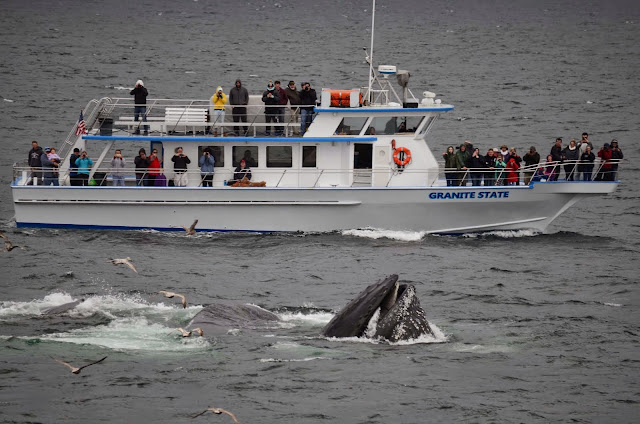Today’s 12pm whale watch onboard the Cetacea was fantastic! We went to the southwest corner where there were 3 other whale watchers in the middle of a humpback extravaganza. There were about 15-20 humpback whales in total, with a large group of at least 6 whales, another group of 4, then two pairs and a group of 3.
Some of the whales were changing associations when we first approached, but we followed the group of 6 as they were feeding with several gulls flying overhead. This group contained Owl and calf, Perseid, Nile, Milkweed, and a few others in the area I have yet to identify.
One had a large amount of new abrasions on its tail stock from a recent injury. I believe this whale has been monitored over the past week but we were able to get a close look at its wounds. It was exhibiting normal behavior, even curious at times, and went right under our boat!
Towards the end the of the trip we saw spinning head breaches from one of the calves! We had 4 breaches in total, with one majestic breach on our last look! It was a beautiful, sunny day on the water and thanks to our crew and Captain Nate we were able to remove a balloon from the water as well.
— Laura Cupicha
Both the 10 am and 2pm trips on this blustery Saturday where filled with excitement and awe at these awesome ocean creatures.
In the morning we headed out towards the southwest corner and were greeted by the fantastic sight 10 whales in our immediate vicinity. Our passengers got amazing looks at Nile, Perseid, Jabiru and her calf, Owl and her calf, and Tornado. A number of unknowns were also seen our much sighting Unknown #17 as well as two whales which did not deem to show us their tails. One of the major things I noticed today was the size difference between these two calves. Owl’s calf is very large at the moment while Jabiru’s calf is still quite tiny. This could mean that Owl’s calf is older or has had the chance to grow faster than Jabiru’s calf. Either way both these animals have tons of energy and I hope to see them for years to come.
This afternoon the southwest corner was not just blustery, it was full on winds which made for difficult but exciting sighting conditions. We found Nile and Perseid traveling together but moved on to group containing Owl and her calf. We weren’t able to identify the other whales but I assume they were probably whales that have been sighted all this week. The calf entertained us with tail breach after tail breach, flipper slapping, and some rolling and swimming underwater. You may see that this little guy has some injuries to its tail that we’ve been monitoring. It’s good to know that these injuries are not keeping it from its calf-ish fun. We moved off towards another whale that was exhibiting beautiful breaches in the distance and I was able to identify Samara, another well-known Stellwagen whale. Samara breached, flipper slapped, and lobtailed for a good 20-25 minutes while we watched. It was the perfect end to another day on Stellwagen Bank.
— Tegan















































